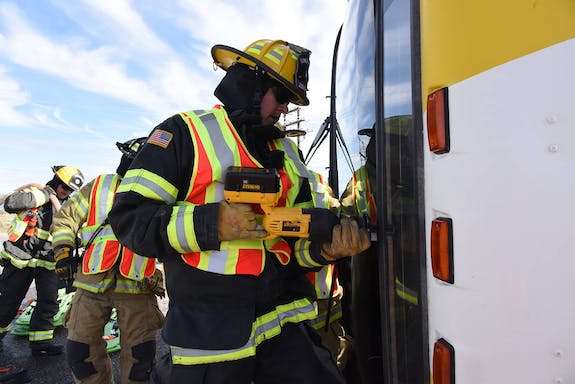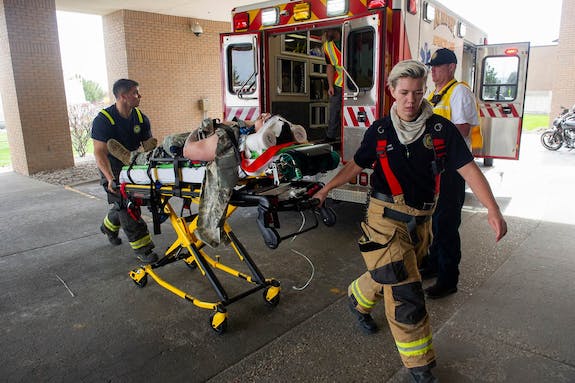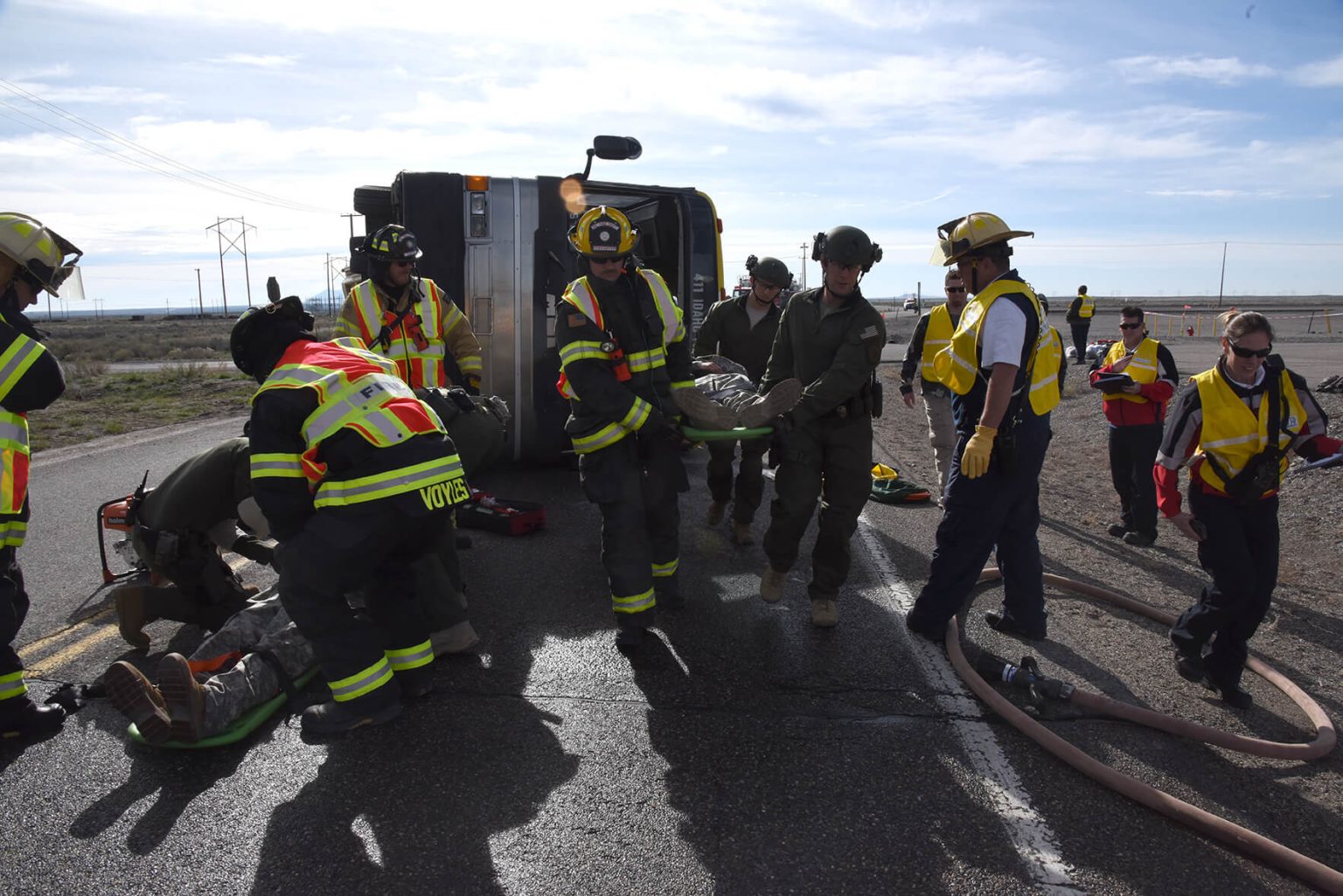Idaho National Laboratory’s emergency exercise planning team dug deep into the playbook of potential risks when creating a lifelike roadway accident scenario involving multiple simulated injuries for the 2019 annual emergency exercise.
At the full-scale exercise on the morning of April 23 at the Central Facilities Area, disciplined chaos ruled the day. A Hollywood screenwriter or video game designer would have been challenged to imagine an emergency scenario with more ambulance sirens and helicopter blades.
In response to the faked pandemonium, emergency response organizations from INL and numerous surrounding agencies cranked into gear. At the scene, and in background emergency operations centers, players relayed information so medical and security experts could sort out the bedlam and care for the suffering players. Firefighters, emergency medical staff and security officers instinctively followed their training. First responders treated scores of simulated injured workers who wore heavy makeup in an overturned INL bus. Three helicopters from regional participating agencies landed at the mock heavy-vehicle accident scene.

“This was an exercise for the record books,” said Ed Anderson, the day’s emergency director at the emergency operations center (EOC) in Idaho Falls. “It was imaginatively drawn up, and it tested our vast response capabilities at the Site and in town.”
The exercise aimed to test the emergency response of INL participants and cooperating agencies to make sure they’re capable of a coordinated response to an emergency scene, can provide medical treatment, notify affected agencies or governments, issue emergency public information, and do all this in a safe manner that protects people and the environment. Actors (INL employees or those from participating agencies) safely carried out the scenario as though it were a real-time event.
Other organizations and individuals playing roles included INL heavy equipment operators, three helicopter ambulances, Butte County coroner and dispatch, Hendrickson’s Towing, DOE-Idaho Operations Office, Idaho State Emergency Medical Services communications center (known as StateComm), and Eastern Idaho Regional Medical Center (EIRMC). INL made off-site notifications to all contiguous counties, federal agencies, state of Idaho agencies, and tribal authorities.
In the exercise scenario, a dump truck traveled from the Central Facilities Area. As the driver approached an intersection, the truck brakes failed. The truck proceeded into the intersection just as an INL bus – carrying about 20 people, including the driver— approached the intersection. In the simulated scenario, the bus driver swerved to avoid a collision but was struck by the dump truck. The bus veered partially off the road and tipped on its side.
Those witnessing the mock incident made emergency calls using 911 and the INL 777 emergency phone number. The INL 777 calls went to the INL Fire Alarm and Emergency Dispatch Center (FAEDC), and the 911 calls went to local county dispatch centers and were transferred to the center, which dispatched INL emergency medical services and fire department resources.
INL Fire Department responded to the scene, established incident command, completed initial scene evaluation, and found multiple injuries. The battalion chief functioning as incident commander declared a mass casualty event. INL Security staff responded to the scene, reported to the incident command, and limited access to the scene. Warning Communications Center (WCC) staff sent notifications of the fire department response using the INL Emergency Notification System.

Firefighters practiced extrication processes to enter the bus and remove mock injured bus riders and the driver while other, less severely injured riders, got out on their own. After removing the injured passengers, fire department and medical staff began to triage. The dump truck driver was simulated to be deceased. INL notified the Butte County sheriff and coroner, and the coroner responded to the scene. Protective Force staff assisted in transporting the most seriously injured bus riders to air ambulances, which transported them to EIRMC.
Early in the scenario, the CFA emergency action manager at the emergency control center (ECC) coordinated with the WCC to activate the emergency response organization for support at the ECC at CFA, the EOC at the INL Administration Building in Idaho Falls, and the joint information center in EROB for emergency public information support.
Prior to the exercise kickoff, East Portland Avenue was closed as part of a road outage, and INL equipment operators staged the accident scene by safely tipping an out-of-service INL bus, which had been drained of its fuel and oil, on its side and positioning the dump truck in the road as if they had collided. Safeguards and Security (security police officers) secured the scene, and the new SPO class acted the parts of the mock injured bus driver and passengers. During triage, responders determined several injured people required urgent transportation to a local hospital. They called for air ambulances, and three medevac helicopters from three outside first-response agencies (Air Methods from Driggs, Portneuf Air Rescue/Classic Air Medical from Pocatello, and Life Flight Network from Burley) responded, and landed at established landing zones. Two helicopters transported two mock-injured victims to EIRMC. Based upon their injuries, four were loaded on INL ambulances and transported to EIRMC while other less severely injured were transported to CFA Medical for further evaluation. Altogether, six mock injured were transported to EIRMC.
Support staff at the ECC and EOC were busy monitoring the event. They completed an initial notification form, then approved and submitted it to the WCC, where staff sent it to off-site stakeholders and agencies.
After a head count for those involved in the mock accident was completed, responders sent fieldworker notifications, advised Bus Operations of the road closure, and rerouted traffic. Names of the simulated injured and deceased were given to the INL medical director, and INL simulated next-of-kin notifications.
INL public information staff developed and simulated distribution of news releases to media and stakeholders throughout the event with assistance from the joint information center. They simulated monitoring local television and radio outlets and social media. One element of the exercise simulated an employee posting photos to social media from the scene. Social media monitoring staff practiced discussing the issue with the EOC command room and providing approved information to clarify, correct and confirm information.

Command bridge briefings between those at the EOC and ECC occurred during the exercise, and the emergency director at the EOC, assured event categorization, classification, notifications, and protective actions were implemented according to procedures. Environmental issues were addressed, and environmental notifications made.
At EIRMC, emergency room medical staff received the simulated injured people transported by air and ground. They assessed the patients and processed them through their system. One person was transferred to the operating room as though needing immediate surgery.
“When you think of all the moving pieces needed to come together, and do everything safely, it was impressive,” said Dwight Stevenson, Environment, Safety, Health & Quality manager for Facilities & Site Services. “The exercise was planned, coordinated and executed safely. When you plan, talk and coordinate things, they work well.”
The emergency centers at CFA and in Idaho Falls, along with the joint information center, worked efficiently together to coordinate responses. As part of the exercise closeout, Hendrickson’s Towing arrived on scene and successfully lifted the bus, rotated it to an upright position while suspended in the air, and placed it back on its wheels. The bus was then towed to the INL fire department drill field to be used in further training evolutions.
“The exercise was a first of its kind in realism and agency coordination,” said Carisa Schultz, exercise planning team and INL Emergency Management public liaison. “It took months of effort on behalf of the multidirectorate planning team to establish contact and coordinate the response among INL and off-site agencies. Practicing at this scale helps ensure a successful response if there is ever a real accident of this magnitude at INL.”
Scott Barnes, INL Drill and Exercise coordinator and exercise director for the annual exercise, said, “What a fun, exciting, and challenging scenario to pull off. It’s difficult to accomplish something this big without a dedicated team who bent over backwards and pulled off some amazing feats to make this happen. It seemed that every person on the team and everyone that we talked to was more than willing to help and assist. As obstacles were identified and quickly removed, it appeared as though everything just fell into place and it was all because of a cohesive and talented exercise team. My hat goes off to the entire team.”
The core team consisted of Carisa Schultz, Garth Lambson, V. Scott Barnes, Brady Austin, Brady Jensen, Paul Bradley, Jaron Ricks, Bill Wells, Jeff Jennings, Mike Eddins, Logan Lewis, Jeff Allen, Steven Hanson and James Burns.
Video of 2019 emergency exercise





